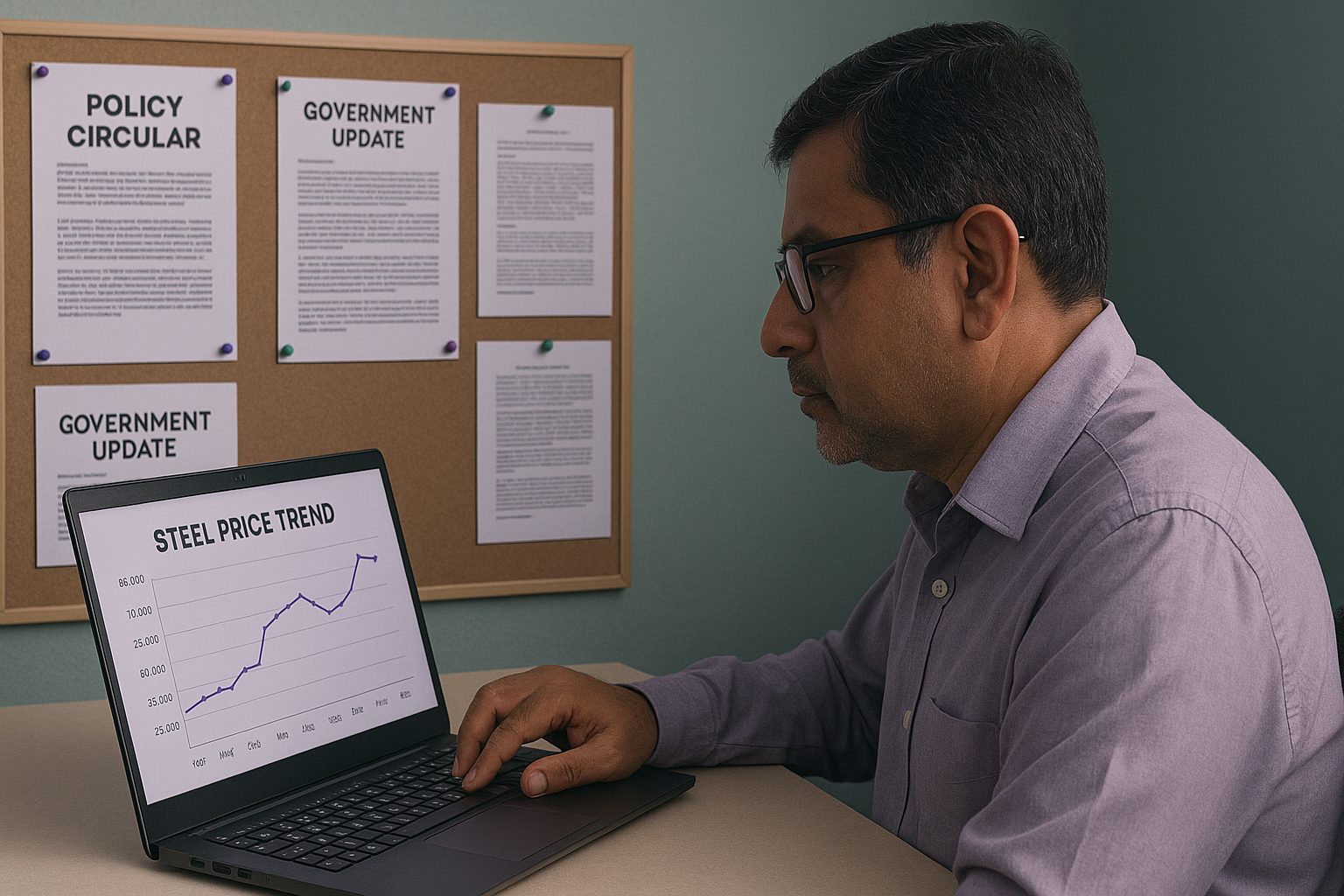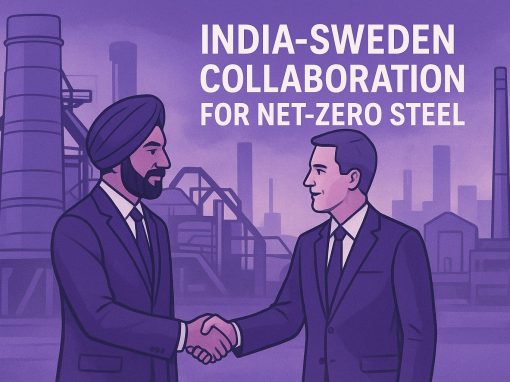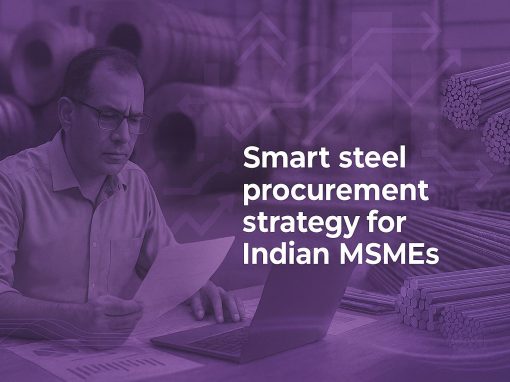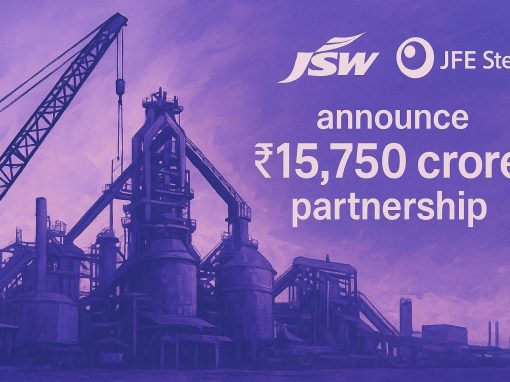Table of Contents
Introduction
Steel price volatility is no longer a distant market headline. It shows up in very ordinary MSME routines, from RFQs to GRN entry. HR coil price, HR sheet price and TMT bar price move in short jumps, not in a smooth curve. A rate that looked safe last week can feel risky by the time material reaches the gate.
In real procurement cycles, timing often beats negotiation skill. Many MSMEs still treat steel price analysis as background noise, not a daily input into planning. That approach increases steel price risk, especially when customers expect fixed quotes and strict schedules.
Typical signs of volatile price movement for MSMEs include:
- Service centres changing hot rolled coil price between quotation and PO
- Stockists revising construction steel prices after sudden iron ore price news
- Fabrication jobs slipping into loss when HR sheet price spikes mid project
- TMT bar price offers diverging sharply across nearby cities on the same day
What this guide will help MSMEs achieve
This guide explains the key drivers of steel price volatility in 2025, how they show up differently in HR coils, HR sheets and TMT bars, and what that means for day to day buying. The aim is simple: help Indian MSMEs turn a noisy market into a more planned procurement routine.
Why 2025 matters for steel buyers (Q4 outlook)
Domestic steel demand in India is still growing, led by government spending on roads, housing and rail projects. Prices, however, have not followed a smooth line. HR coils, sheets and TMT bars have all seen phases of softening followed by sudden jumps, which makes planning hard for MSMEs that bid months in advance.
Key points:
- Infrastructure and housing keep demand firm.
- Prices move in short bursts instead of steady trends.
- Smaller buyers feel the impact first because margins are thin.
Import pressure and mill pricing
Cheap imports from countries such as China, Japan and South Korea have put pressure on flat steel prices in 2025. At the same time, Indian mills face higher costs for metallurgical coal, scrap and logistics, and respond with frequent price circulars.
For MSMEs, this shows up as:
- One month of low import-linked offers, then sharp domestic revisions.
- City wise differences in HR coil and sheet quotes for the same sizes.
- Weekly purchase cycles turning into constant rate renegotiations.
Policy and compliance shifts in Q4 2025
Policy and compliance changes add another layer of uncertainty. Safeguard and trade remedy actions on select flat steel products keep import offers unpredictable and give domestic mills more room to lead price moves. New and tighter BIS norms for structural and reinforcement grades push MSMEs to upgrade mill certificates and documents or risk rejection at the tender stage.
In Q4 2025 this creates a market where prices can move faster than smaller buyers can react, unless procurement is planned with more discipline and better information.
With this context in mind, let’s now have a look at the key factors driving steel price volatility in the year 2025.
Also read: Steel Plants in India (2025): Top Producers & Projects
Key factors affecting steel prices
Steel prices move because many forces act at the same time, in India and outside. Some factors change slowly, like technology or long term demand. Others, like coal prices or a new duty on imports, can move within weeks and show up quickly in HR coil, sheet and TMT offers.
For MSMEs, these drivers matter because they decide whether the next quote from a stockist is higher, lower or unchanged. Understanding them makes it easier to judge if a sudden change is structural or just a short term spike.
1. Raw Material Costs:
The steel production industry utilises iron ore together with coal particularly coking coal and scrap metal as its primary raw materials. The market prices of raw materials directly affect the prices of steel products in a major way. Supply difficulties combined with higher demand for iron ore automatically triggers a rise in steel market prices. A reduction in raw material prices drives down the cost of steel products in the market.
2. Supply and Demand Dynamics:
Steel prices operate according to the basic economic principles between supply and demand like all other commodities. The rising demand from construction combined with the automotive along with infrastructure development projects repeatedly leads to steel price elevation.
The price of steel increases when the main sectors expand their use of steel but decreases when both these sectors demonstrate reduced activity or when steel production exceeds market needs. Global economic development plays an essential role since strong industrial development typically increases steel market requirements while heightening steel prices.
3. Energy Prices:
Production of steel includes high energy usage which creates an energy-intensive industrial process. The price volatility of electricity and natural gas affects production expenses for steel manufacturers which translates to changes in steel price levels.
The steel sector must adjust their manufacturing costs when energy prices rise because it leads to profit erosion which requires increased pricing; alternatively lower energy prices enable producers to lower their steel costs.
4. Government Policies and Regulations:
The prices of steel depend heavily on various government policies together with trade regulations and environmental regulations. The implementation of tariffs on imported steel results in higher import costs thus improving domestic steel market competition which may cause prices to rise.
Higher steel mill production expenses resulting from enhanced environmental regulations play a role in elevating the price of steel products. Investments from the government through infrastructure ventures simultaneously increase both steel market demand and selling prices.
Must read: Union Budget 2025: Key Expectations for Steel Infra Industries
5. Currency Exchange Rates:
International steel trades require proper evaluation of currency exchange rates since exchange rates profoundly affect pricing.
Changes in exchange rates create price fluctuations for imported steel which will also determine market competitiveness of domestic steel producers. When the domestic currency strengthens it makes imported steel products cheaper which could possibly lower domestic steel price levels.
6. Global Economic Conditions:
The condition of the worldwide economic system acts as the primary factor that shapes steel market values. Higher economic development in leading markets like China together with the United States and European regions normally boosts steel consumption which consequently increases prices. Economic recession together with slowdowns in the economy reduce market demand thus lowering steel prices.
7. Technological Advancements:
The prices of steel are affected by long-term changes in production technological advancements. Innovations that enhance production efficiency and control costs and utilize different raw materials for steel production tend to cause steel price reductions.
The implementation of innovative technologies demands substantial capital investments which might result in higher prices during initiation.
Must read: Steel innovations in the construction sector
8. Speculation and Market Sentiment:
The metal price value of steel responds to the same forces that affect other commodities through speculative bets and changing market sentiments. Price movements regarding the future act as a basis for traders and investors to place bets which then create market volatility.
Market sentiment combined with news events along with geopolitical developments that predict future supply and demand patterns leads to both changes in market sentiment and volatile steel price market.
9. Scrap Metal Prices:
Electric arc furnaces utilize significant quantities of scrap metal materials for steel production purposes. The cost to produce steel rises and steel prices escalate when scrap metal prices undergo changes. The behaviour of steel prices either rises or falls according to the price of scrap materials.
Must read: Iron scrap rate today – Prices per kg, daily rates (Jan 2025)
10. Seasonal Factors:
The price performance of steel is sometimes affected by seasonal aspects in select areas. Building projects generally reduce their operations during severe winter seasons which reduces steel consumption and causes market prices to decrease. The rise of construction work in favorable temperatures generates both enhanced market requirements and increased product prices.
How volatility differs across HR coils, HR sheets and TMT bars
Steel prices do not move as one single line. Hot rolled coils, HR sheets and TMT bars each react differently to demand, raw materials and regional factors. For MSMEs, this matters when costing tenders, planning inventory or choosing between spot and contract buying.
HR coils
HR coils sit at the centre of the flat steel market. Many products that MSMEs use later, such as sheets, plates and pipes, begin as coils. That is why coil prices often move first and fastest.
Key reasons for HR coil volatility:
- Import pressure and trade measures
HR coil is heavily traded across borders. Cheap offers from East Asian suppliers in some months pull domestic prices down. When safeguard duties or other trade measures are proposed or revised on flat products, domestic coil prices can harden within a short time. - Demand from core sectors
Auto, appliances, machinery and infrastructure all draw from the coil market. A strong order book in these sectors supports higher prices, while a slowdown creates inventory and discounting pressure. - Raw material and energy swings
Changes in iron ore, coking coal and energy cost feed directly into coil production cost. Mills often reflect these moves through regular price circulars, which then pass to stockists.
What this means for MSMEs:
- Coil-based buyers see more frequent price revisions.
- Negotiations often hinge on import parity and mill circulars.
- Costing for coil-based components needs regular review, not once a year.
HR sheets
HR sheets are produced from coils by cutting, levelling and sometimes further processing. Sheet prices broadly follow coil trends but add their own local and service-related layers.
Key reasons for HR sheet volatility:
- Conversion and service centre margins
Service centres add costs for slitting, cutting and holding inventory. When coil prices rise, sheet prices can move more than the base change because both input cost and service margins adjust. - Thickness, size and specification mix
Sheets in popular thickness and standard sizes may stay tight even when the wider market looks soft. Cut-to-size or special grades can attract sharp premiums that change quickly with demand. - Regional demand and stock position
HR sheets serve fabrication, machinery and structural work in local industrial clusters. If one city or belt is busy with projects, local sheet prices may stay firm while another region sees discounts.
What this means for MSMEs:
- Fabricators and machinery units must track both coil and local sheet rates.
- A quote for a fixed thickness and size can go out of date quickly if service centre stocks are low.
- Comparing sheet prices across nearby cities can sometimes reveal better options than relying on one local supplier.
TMT bars
TMT bars are the main reinforcement material for housing, commercial projects and infrastructure. Long product prices often behave differently from flat products such as coils and sheets.
Key reasons for TMT bar volatility:
- Construction cycle and seasonality
TMT demand rises with active construction and slows during heavy monsoon or when approvals are delayed. Prices can firm up quickly before major project pushes or year-end completion drives, then cool off when site activity dips. - Primary versus secondary route
Primary mills use integrated routes with billets from their own steelmaking operations. Secondary mills depend more on scrap or sponge iron and local power. Moves in scrap prices, sponge iron and electricity tend to make secondary TMT more volatile, especially in regional markets. - Regional mill competition and freight
TMT usually travels shorter distances than coils. Local oversupply, shutdowns or freight changes within a region can move prices even if national averages appear steady.
What this means for MSMEs:
- Contractors and builders must factor TMT swings into long project bids and escalation discussions.
- Buying only on a weekly basis, without a view of local mill plans or seasonal site activity, increases the risk of landing steel at peak prices.
- For projects spread across states, regional TMT price differences can be large enough to influence site-wise sourcing decisions.
Also read: Top 10 TMT Bars in India – Know which is best for your project
What steel price swings mean for MSMEs
Price swings in steel do not hit all businesses the same way. Large producers can hedge their positions or carry excess stock. Smaller firms rarely have that cushion. For MSMEs, even a modest jump in price can upset tenders, delay supply, and stretch working capital.
Procurement risks
The tendering cycle is where the first cracks appear. Many MSMEs quote at fixed rates in government or EPC contracts. If steel becomes costlier before the order is executed, the loss sits with the bidder. Some suppliers withdraw earlier offers when costs rise, leaving the buyer to renegotiate at the last minute. This weakens client confidence and often delays dispatch.
Day-to-day operations
Stockholding is another challenge. Few small units have space or money to maintain large inventories. Most buy weekly or fortnightly. When rates move quickly, each round of purchase becomes costlier. A delayed delivery of steel sections or rebars can bring fabrication or construction work to a halt.
Cash flow pressure
The financial strain is immediate. Paying more upfront to stockists (retailers/distributors), while waiting longer for client payments, creates a squeeze. Without tools like invoice discounting or supply-chain finance, many firms struggle to balance routine expenses.
For MSMEs, steel volatility is not just a market story – it cuts through procurement, operations, and finance. That is why smarter buying strategies are no longer optional but necessary.
Also read: What is Sariya? Explore its Grades, Applications, and Prices
Procurement playbook – buy smarter when prices move
Price swings are now a routine part of steel buying. MSMEs cannot control the market, but they can change how they buy. A clear playbook helps firms cut exposure and avoid last-minute shocks.
Spot versus contract supply
Buying from the spot market is quick but unpredictable. When prices climb sharply, small firms with thin margins absorb the loss. Contract supply, even for three months, offers more stability. In several state housing projects this year, contractors with basic escalation clauses in their supply agreements were able to deliver on time, while those tied to weekly purchases ran into cost overruns.
Building stronger supplier relations
Reliable supply often depends less on the market and more on the partner. MSMEs that track suppliers on delivery record, payment terms and willingness to hold stock gain an advantage. Even a simple checklist helps identify which stockists stand firm during shortages and which ones keep changing terms.
Writing clear RFQs
A well-drafted RFQ can prevent later disputes. Stating delivery deadlines, acceptable price-revision bands and penalties for late supply gives buyers more certainty. Clear terms reduce the need for renegotiation mid-project.
For smaller firms, buying smarter does not mean predicting the market. It means locking in reasonable terms, tracking supplier behaviour, and avoiding sudden shocks in cost and delivery.
Conclusion
In an ever-changing market, factors affecting steel prices continue to shape the industry’s pricing trends and profitability. The interplay of raw material costs, production challenges, economic conditions, and international trade policies drives price variations, impacting manufacturers and consumers alike.
Apart from it, the year 2025 has shown that steel prices can shift faster than many MSMEs can react. The last quarter is the time to put discipline into buying. A contract with a clear escalation clause, a second supplier lined up, and paperwork checked before tender submission are not big tasks – but they prevent heavy losses when prices jump.
The market is unlikely to turn stable in early 2026. Government projects, global trade tensions and tighter standards will keep demand and compliance pressures high. Firms that end this year with organised supply terms and a written playbook will cope better with what comes next.
For MSMEs, the message is direct: treat procurement as planned work, not an afterthought. Preparation now will decide whether projects run smoothly or face avoidable cost and delivery shocks in the months ahead.
Looking to procure steel?
Tata nexarc helps manufacturers, builders and MSMEs source certified steel products, compare prices, and choose the right grade as per IS codes—with complete traceability and procurement confidence.
FAQs
Why do steel prices fluctuate?
Are steel prices predictable?
What effect do interest rates have on steel prices?
What is the impact of government infrastructure spending on steel prices?
How can MSMEs keep tender bids safe from price changes?
What buffer stock is practical for smaller firms?
Should MSMEs prefer monthly or quarterly supply contracts?
Can small firms use commodity exchanges to manage price risk?
Charul is a content marketing professional and seasoned content writer who loves writing on various topics with 3 years of experience. At Tata nexarc, it has been 2 years since she is helping business to understand jargon better and deeper to make strategical decisions. While not writing, she loves listing pop music.











